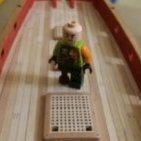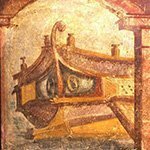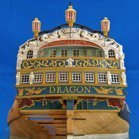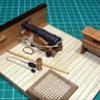Supplies of the Ship Modeler's Handbook are running out. Get your copy NOW before they are gone! Click on photo to order.
×
-
Posts
7,982 -
Joined
-
Last visited
Reputation Activity
-
 Louie da fly got a reaction from GrandpaPhil in 10th-11th century Byzantine dromon by Louie da fly - FINISHED - 1:50
Louie da fly got a reaction from GrandpaPhil in 10th-11th century Byzantine dromon by Louie da fly - FINISHED - 1:50
Some more oarsmen, and a nice background picture. It's a reconstruction of the Byzantine harbour of Theodosius (where the Yenikapi ships were found). It would be good to make one of those background pictures big enough to look like it's a real background, but I'll have to wait till lockdown is over so I can get to a shop that does it.
My wife tells me I have to stop making these figures, otherwise I'll go blind. I've decided I'll only do it till I need glasses.
Oh.
-
 Louie da fly reacted to mbp521 in Viking longship by Cathead - Dusek - 1:35 - FINISHED
Louie da fly reacted to mbp521 in Viking longship by Cathead - Dusek - 1:35 - FINISHED
Looking good Eric. Great idea with the binders. I’ve tried using finger clamps before hold pieces in place on each side, but the swivel feet made it difficult to line up on both sides. I’m going to keep this method in my back pocket for future use.
It’s just a thought, but the color of stain that you are using looks great on there. I would think that a couple of more coats would give you the desired color you are looking for and may help alleviate the visible wavy lines of the wood.
-Brian
-
 Louie da fly reacted to Jim Lad in Viking longship by Cathead - Dusek - 1:35 - FINISHED
Louie da fly reacted to Jim Lad in Viking longship by Cathead - Dusek - 1:35 - FINISHED
She's coming together nicely, mate!
John
-
 Louie da fly reacted to Cathead in Viking longship by Cathead - Dusek - 1:35 - FINISHED
Louie da fly reacted to Cathead in Viking longship by Cathead - Dusek - 1:35 - FINISHED
And here's the model with two full strakes attached. It's nice outside, so I took it out of the frame and went outdoors for some better lighting. Almost got stung by a wasp that was nesting under this porch bench and didn't appreciate me using it. Maybe I'll paint this black and yellow and name it the Old Norse term for wasp.
As I think I said before, I'm planning to repaint the finished hull for a darker, more tar-like tone so am not worrying about the uneven finish in the initial staining. You can see the really coarse wavy grain in the original wood, which is another reason I want to repaint the finished product. I also want to help blend the ends of the strakes into the keel, either by sanding them down or by using some kind of filler to extend them. I might even try to make false joints so it looks like the pre-formed stem/stern that many real ships used.
-
 Louie da fly reacted to Binho in Viking longship by Cathead - Dusek - 1:35 - FINISHED
Louie da fly reacted to Binho in Viking longship by Cathead - Dusek - 1:35 - FINISHED
Smart idea with the binder clip aligners, wish I had thought of that! I had the same issues getting the strakes to fit in each others' curves, but it did get better as I built updwards.
-
 Louie da fly reacted to Cathead in Viking longship by Cathead - Dusek - 1:35 - FINISHED
Louie da fly reacted to Cathead in Viking longship by Cathead - Dusek - 1:35 - FINISHED
I've been pre-soaking the planks using an old rain gauge tube, which works great:
After 20-30 minutes, I clamp them in place on the hull, let them dry, then attach with glue. Works great.
One thing I really wanted to get right was keeping the strakes on both sides of the hull aligned at stem and stern so they'd look good when viewed from the ends. So I came up with this simple idea for ensuring consistency. Once the first side was glued down, I used a few binder clamps to "mark" that position equally on both sides. For example, here is the first strake glued on:
One binder clip marks the very tip of the plank, the next two are parallel to its outer curve. Since the clamps are the same size on both sides, their edges mark the exact location where the opposite plank should go. So when I set the opposite plank up, I could nestle it right in among these clips and know it was right, without needing to mark lines. This also helped hold the plank in place.
Here's another example, using the second strake. First, clip marking the installed strake's location:
And opposite side showing exactly where the next one needs to go:
Sharp eyes will notice that I've been having a devil of a time getting the strakes to fit inside each others' curves perfectly. I'm doing my best and expect to maybe use a tiny bit of filler. I think it'll overall vanish into the broader hull's pattern, and I'm learning how these interact as I go, so I think the upper (and more visible) ones will be better. I also think this one slid a little under the clamp, something I'm now being more careful about it.
-
 Louie da fly got a reaction from FriedClams in HMS Tiger 1747 by Siggi52 - 1:48 - 60 gun ship from NMM plans
Louie da fly got a reaction from FriedClams in HMS Tiger 1747 by Siggi52 - 1:48 - 60 gun ship from NMM plans
And it's a particularly good reproduction of the "Chinoiserie" style of lion fiurehead that was so popular at the time, right down to the expression on its face.
-
 Louie da fly got a reaction from GrandpaPhil in 10th-11th century Byzantine dromon by Louie da fly - FINISHED - 1:50
Louie da fly got a reaction from GrandpaPhil in 10th-11th century Byzantine dromon by Louie da fly - FINISHED - 1:50
Thanks everybody for all the likes and comments.
Christos, glad you like the background. There was a discussion earlier in the build regarding the oarblade width - I was also worried they were too narrow, but (i) they had to fit through the oarports which are copied from one of the Yenikapi galleys, (ii) they were based on Byzantine illustrations (though if I had to do it again I'd make the blades taper more slowly, so the blade would come higher up the shaft as shown here)
and (iii) I was assured that this is a representative width for an oarblade propelling a decent sized vessel - I've had a quick look for it in the (45 pages of) my build log but can't find it at the moment.
Banyan, that's a tempting thought, but I think I'd be happy just to blow the picture up bigger so it forms a background. There's another one that's even nicer (got it off Pinterest) which I'd like to use even more than the one above.
But each of them contains a picture of a dromon that I don't believe is correct. I could probably photoshop it out, though, or just put the model in front so it can't be seen.
-
 Louie da fly got a reaction from goetzi73 in 10th-11th century Byzantine dromon by Louie da fly - FINISHED - 1:50
Louie da fly got a reaction from goetzi73 in 10th-11th century Byzantine dromon by Louie da fly - FINISHED - 1:50
Some more oarsmen, and a nice background picture. It's a reconstruction of the Byzantine harbour of Theodosius (where the Yenikapi ships were found). It would be good to make one of those background pictures big enough to look like it's a real background, but I'll have to wait till lockdown is over so I can get to a shop that does it.
My wife tells me I have to stop making these figures, otherwise I'll go blind. I've decided I'll only do it till I need glasses.
Oh.
-
 Louie da fly got a reaction from druxey in Translation help needed - Renaissance German
Louie da fly got a reaction from druxey in Translation help needed - Renaissance German
Thanks, Matle. Von Grünenberg, as is to be expected from a member of the mediaeval/renaissance ruling class, was almost obsessed with heraldry, and I'd be prepared to believe that every coat of arms portrayed is accurate.
Yes, that one I knew from the text. But the fortifications shown are not as they are now.
Either the artist got it wrong or (more likely) they were rebuilt to cope with the new more powerful cannons coming into use at this time. Tall walls and tall towers were vulnerable, and new, more compact forms were coming in - see the fortifications of Malta which were built in the first half of the 16th century.
[Edit]Compare this with the marine gate at Rhodes, built when artillery wasn't such an issue, and the main thing to guard against was people scaling the walls. So walls were built very high, with battlements to deter climbers and infantry. Cannons changed all that - one of the main reasons the Turkish conquest of Constantinople succeeded.
And here's some information about von Grünenberg himself - https://www.petersommer.com/blog/another-view/gruenenberg-1486-croatia-greece - apparently he was the artist! And you can find the whole book at https://digital.blb-karlsruhe.de/blbhs/content/thumbview/7681 - amazing! I'm very glad I followed this up. Strangely, one of the pics I'm most interested in - of Sibenik in Croatia (because it has a great picture of a carrack in it) in this version the ship is different.
This is the one I'd like to get in more detail: it's attributed to von Grünenberg
And this is what the above archive has:
Same city, same configuration, same coat of arms (though reversed out), but different. Presumably they re-drew the pic for another edition. Dammit!
Oh, and if you want some more carracks, the Peregrinatio in Terram Sanctum (Pilgrimage in the Holy Land) by von Breydenbach has some good pictures; https://www.alamy.com/stock-photo/von-breydenbach.html
[/Edit]
-
 Louie da fly got a reaction from goetzi73 in 10th-11th century Byzantine dromon by Louie da fly - FINISHED - 1:50
Louie da fly got a reaction from goetzi73 in 10th-11th century Byzantine dromon by Louie da fly - FINISHED - 1:50
Thanks everybody for all the likes and comments.
Christos, glad you like the background. There was a discussion earlier in the build regarding the oarblade width - I was also worried they were too narrow, but (i) they had to fit through the oarports which are copied from one of the Yenikapi galleys, (ii) they were based on Byzantine illustrations (though if I had to do it again I'd make the blades taper more slowly, so the blade would come higher up the shaft as shown here)
and (iii) I was assured that this is a representative width for an oarblade propelling a decent sized vessel - I've had a quick look for it in the (45 pages of) my build log but can't find it at the moment.
Banyan, that's a tempting thought, but I think I'd be happy just to blow the picture up bigger so it forms a background. There's another one that's even nicer (got it off Pinterest) which I'd like to use even more than the one above.
But each of them contains a picture of a dromon that I don't believe is correct. I could probably photoshop it out, though, or just put the model in front so it can't be seen.
-
 Louie da fly got a reaction from GrandpaPhil in Viking Longship by Binho - Dusek - Scale 1:72 - Model based on the 11th Century Skuldelev 2 wreck
Louie da fly got a reaction from GrandpaPhil in Viking Longship by Binho - Dusek - Scale 1:72 - Model based on the 11th Century Skuldelev 2 wreck
I like the blue-red-blue-yellow-blue, 7th from the top. I hadn't thought of the Bayeux Tapestry for a colour guide, but of course all the ships have alternating colours in the planking. Doubt has been cast on th "reality" of the colours in the BT (which has green and blue horses, among other things), but every now and then a discovery comes up that confirms its accuracy - such as the horizontal stripes on the mound (known as a motte) that the Norman fort at Hastings is built on -
Turns out that when they excavated one, it was built with alternating layers of different materials . . .
By the way, IIRC they found yellow (orpiment) paint on the head of the steering oar of the Gokstad ship.
-
 Louie da fly reacted to KrisWood in Gokstad c. 900 AD by bigpetr - 1:48 - CARD - viking ship
Louie da fly reacted to KrisWood in Gokstad c. 900 AD by bigpetr - 1:48 - CARD - viking ship
I thought of some new search keywords on the museum photo portal and while I was looking through Oseberg drawings from the excavation I came across this detailed drawing of a sea chest and thought of the conversation we've been having here so I decided to share it:
Caption:
Norwegian: Osebergfunn fra mappe 'Oseberg, kister': Detalj snitt målestokk M:1/5 og M:1/2. Tusjtegning av ukjent tegner, rentegnet. Mål: B: 51,3 cm, H: 48,5 cm.
English: Oseberg finds from folder 'Oseberg, chests': Detail section scale M: 1/5 and M: 1/2. Pen drawing by unknown artist, interest drawn. Dimensions: W: 51.3 cm, H: 48.5 cm.
License: CC BY-SA 4.0
Since the Oseberg Ship and the Gokstad ship were only ~20 years apart and both found in the same region, I suspect Gokstad would have had similar chests.
-
 Louie da fly got a reaction from EJ_L in 10th-11th century Byzantine dromon by Louie da fly - FINISHED - 1:50
Louie da fly got a reaction from EJ_L in 10th-11th century Byzantine dromon by Louie da fly - FINISHED - 1:50
Some more oarsmen, and a nice background picture. It's a reconstruction of the Byzantine harbour of Theodosius (where the Yenikapi ships were found). It would be good to make one of those background pictures big enough to look like it's a real background, but I'll have to wait till lockdown is over so I can get to a shop that does it.
My wife tells me I have to stop making these figures, otherwise I'll go blind. I've decided I'll only do it till I need glasses.
Oh.
-
 Louie da fly got a reaction from Binho in Gokstad c. 900 AD by bigpetr - 1:48 - CARD - viking ship
Louie da fly got a reaction from Binho in Gokstad c. 900 AD by bigpetr - 1:48 - CARD - viking ship
Obviously not rowing yet - otherwise the bosun would be tearing strips off them for catching crabs and seagulls . . .
-
 Louie da fly got a reaction from Canute in Wütender Hund by ccoyle - FINISHED - Shipyard - 1/72
Louie da fly got a reaction from Canute in Wütender Hund by ccoyle - FINISHED - Shipyard - 1/72
Very true. I have to force myself to stay focussed on my current build - otherwise I'd be starting all kinds of new ones. I have a list a mile long of models I'd like to make, and it takes a considerable mental effort to keep on the same one and get it finished, particularly when I'm doing something repetitve and boring, but necessary to finish the model.
Even now I've got two under way rather than one, but I've at least put one on hold till the other is finished.
-
 Louie da fly got a reaction from Siggi52 in 10th-11th century Byzantine dromon by Louie da fly - FINISHED - 1:50
Louie da fly got a reaction from Siggi52 in 10th-11th century Byzantine dromon by Louie da fly - FINISHED - 1:50
Some more oarsmen, and a nice background picture. It's a reconstruction of the Byzantine harbour of Theodosius (where the Yenikapi ships were found). It would be good to make one of those background pictures big enough to look like it's a real background, but I'll have to wait till lockdown is over so I can get to a shop that does it.
My wife tells me I have to stop making these figures, otherwise I'll go blind. I've decided I'll only do it till I need glasses.
Oh.
-
 Louie da fly got a reaction from Binho in 10th-11th century Byzantine dromon by Louie da fly - FINISHED - 1:50
Louie da fly got a reaction from Binho in 10th-11th century Byzantine dromon by Louie da fly - FINISHED - 1:50
Yes, what Strelok said, except that the Empire was actually split in two, with a senior and junior Emperor (Augustus and Caesar) for each half, for purposes of easier administration, quite a while before Constantine. Constantine moved the capital from Rome to Byzantion, but in fact he reuinited the Empire - at least for a while. It stretched from Italy, through the Balkans, to the eastern border of Asia Minor (modern Turkey), and incorporated Egypt and much of North Africa. Territorial losses over the centuries reduced the size of the Empire, but it was a very international phenomenon.
Though the language of the Empire after maybe the 6th or 7th century was Greek, (and the term "Byzantine" to describe them was coined by Western scholars much later) they called themselves Romans right up to the end.
-
 Louie da fly got a reaction from Binho in Viking Longship by Binho - Dusek - Scale 1:72 - Model based on the 11th Century Skuldelev 2 wreck
Louie da fly got a reaction from Binho in Viking Longship by Binho - Dusek - Scale 1:72 - Model based on the 11th Century Skuldelev 2 wreck
Very interesting and attractive colour scheme, Binho. As far as I know there's no archaeological evidence either way on colour so you've got open slather . . .
-
 Louie da fly got a reaction from jchbeiner in Translation help needed - Renaissance German
Louie da fly got a reaction from jchbeiner in Translation help needed - Renaissance German
Thanks for the likes and for the replies.
Matle, I'd agree that it would be unlikely for Turks at that time to put an animal figurehead on a ship. However there were plenty of people who'd already been in shipping when the Turks took over, who would have simply continued in business, and it may have been such a ship. And yes, such figureheads are quite common on contemporary pictures of carracks, and the discovery of the Gribshunden one was a wonderful proof that they really did exist.
Cotrecerf, thanks in particular for the translation. That's very helpful indeed. It links together what I'd made from my poor attempts at translating and makes it all into a coherent whole. I think you might be right - that von Grünemberg would have considered himself "above" making his own drawings and local artists to illustrate his account of the pilgrimage once he got home. Certainly some other pictures in his account support that idea - particularly that whoever drew the pictures didn't fully understand how a lateen sail works.
On the other hand, the level of detail in the drawings suggests someone who actually observed the ships first hand, even if lateen sails confused him. Look at the placement of the lifeboat on the galley, the supports below the oar outrigger, and other details. And though galleys did get at least as far into the Atlantic as Antwerp (I have a picture from 1515) the ship behind the galley and the ship on the left in the picture below are vessels characteristic only of the Mediterranean. It's my opinion that von Grünemberg took an artist with him to illustrate the journey. The flag with the complex red cross on it is directly connected with the Kingdom of Jerusalem - though Jerusalem had fallen centuries before, the "kingdom in exile" still existed. With some research it would probably be possible to track down the yellow and blue striped coat of arms on the galley's awning and banners. Just below the "crow's nest" is a note in red which seems to say "Duser galleig" - perhaps it's from the port of Durazzo/Durres in the Balkans?
The idea of the balls being clay containers for fire weapons is interesting. Perhaps that really is what they were.
Amateur, I agree about the bonnet. I think the artists just missed a bit of line immediately to the right and left of the wolf's head which would have made it complete.
-
 Louie da fly got a reaction from jchbeiner in Translation help needed - Renaissance German
Louie da fly got a reaction from jchbeiner in Translation help needed - Renaissance German
Thanks everybody for the feedback. Unfortunately the combination of old script and old language make it very difficult. Lacking anyone who can read the old script we're reduced to guesswork. So farit seems to say something like
"They stood (have stood) [stundge . . ssen?] for (i.e. towards) Modon someone said eight hundred [mo. . g?] of the Turkish [ship?]" - so to m this means they wanted to go to Modon and were charged 800 of some monetary unit .
I'd like to investigate this further, but at least I'm pretty sure that the answer to my original question as to whether this is a Turkish ship is yes.
Jaager, you're right - those are rubbing strakes - they were quite common on carracks before 1500. The "circular attachments" look ball-shaped to me - I'm pretty sure they're not shields, but I have no idea what purpose they would serve, except perhaps for signalling or something of the sort - like the black ball that is dropped down the mast at noon on land to tell ships what the time is.
Normally that netting is to deter boarders, but I can't see it being used that way at the top of a mast . . . They usually put netting over the decks in case of attack, but that's not shown here (maybe not installed in normal times?)
The "stitched supplement" is a bonnet - removing it was how you decreased the area of your sail before reef-points came into use. I think this is an artist error - if you look carefully you can see at the far left (i.e. port) side of the sail there's just a bit of the seam between the mainsail and the bonnet. I think the artist just forgot to put the rest of it in.
I agree about the seagoing abilities of the Turks at the time. They had been a steppe race and the sea was a bit of a mystery to them, at least at first. I seem to recall that during the siege of Constantinople (I think one earlier than their final conquest of 1453) their fleet was cobbled together from whatever they could lay their hands on, and reinforcements from one of the Italian republics were able to get past because of the inability of the Turkish ships to stop the big, modern ships coming to Constantinople's aid. However, they seem to have learnt fast -or employed people wit the knowledge and technology. I know of at least two other pictures from about the end of the 15th century showing big carracks in Turkish use - the Piri Reis map of 1513, and the picture of the Battle of Zonchio of 1499. By 1565 they were certainly in use by the Turks - the Knights of Malta captured one belonging to a high court official - possibly one of the reasons for the Turkish invasion of Malta that year.
A lot of other interesting details in this picture - you can see the wedges of the mainmast, either sheaves or scuppers in the hull, at least two of them are sheaves - one for the maintack and one for the main sheet - lots of interesting rigging details including topping lifts, showing the shape of the blocks in use, the shrouds seem to be tied directly to a side rail, there'saladder to the quarterdeck which doesn't seem to quite make it all the way up, and what are those sort of grating things next to it, with "blobs" on top of the uprights? Perhaps something similar to the openwork sides of the poop superstructure?
Fascinating stuff . . .
-
 Louie da fly reacted to Matle in Translation help needed - Renaissance German
Louie da fly reacted to Matle in Translation help needed - Renaissance German
That’s a Contarini galley (the blue and yellow is indeed their arms) - Contarini was based in Venice and ran charter tours to Jerusalem for pilgrims. I believe he had a more or less a monopoly when Konrad went, so I guess Konrad travelled with him.
The town on the last image is Ragusa (Dubrovnik) by the way.
-
 Louie da fly got a reaction from mtaylor in 10th-11th century Byzantine dromon by Louie da fly - FINISHED - 1:50
Louie da fly got a reaction from mtaylor in 10th-11th century Byzantine dromon by Louie da fly - FINISHED - 1:50
Some more oarsmen, and a nice background picture. It's a reconstruction of the Byzantine harbour of Theodosius (where the Yenikapi ships were found). It would be good to make one of those background pictures big enough to look like it's a real background, but I'll have to wait till lockdown is over so I can get to a shop that does it.
My wife tells me I have to stop making these figures, otherwise I'll go blind. I've decided I'll only do it till I need glasses.
Oh.
-
 Louie da fly reacted to druxey in 10th-11th century Byzantine dromon by Louie da fly - FINISHED - 1:50
Louie da fly reacted to druxey in 10th-11th century Byzantine dromon by Louie da fly - FINISHED - 1:50
The ensemble effect of the oarsmen is looking great, Steven!
-
 Louie da fly got a reaction from BANYAN in 10th-11th century Byzantine dromon by Louie da fly - FINISHED - 1:50
Louie da fly got a reaction from BANYAN in 10th-11th century Byzantine dromon by Louie da fly - FINISHED - 1:50
Some more oarsmen, and a nice background picture. It's a reconstruction of the Byzantine harbour of Theodosius (where the Yenikapi ships were found). It would be good to make one of those background pictures big enough to look like it's a real background, but I'll have to wait till lockdown is over so I can get to a shop that does it.
My wife tells me I have to stop making these figures, otherwise I'll go blind. I've decided I'll only do it till I need glasses.
Oh.











